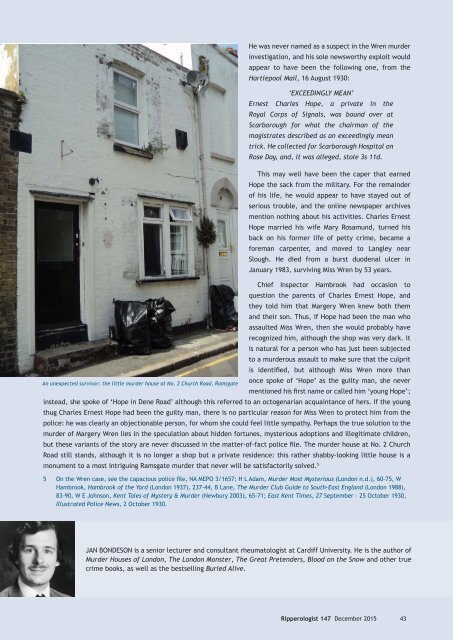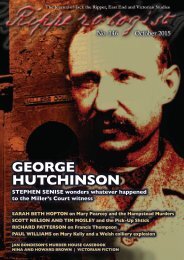Edmund Reid
nuhf574
nuhf574
Create successful ePaper yourself
Turn your PDF publications into a flip-book with our unique Google optimized e-Paper software.
An unexpected survivor: the little murder house at No. 2 Church Road, Ramsgate<br />
He was never named as a suspect in the Wren murder<br />
investigation, and his sole newsworthy exploit would<br />
appear to have been the following one, from the<br />
Hartlepool Mail, 16 August 1930:<br />
‘EXCEEDINGLY MEAN’<br />
Ernest Charles Hope, a private in the<br />
Royal Corps of Signals, was bound over at<br />
Scarborough for what the chairman of the<br />
magistrates described as an exceedingly mean<br />
trick. He collected for Scarborough Hospital on<br />
Rose Day, and, it was alleged, stole 3s 11d.<br />
This may well have been the caper that earned<br />
Hope the sack from the military. For the remainder<br />
of his life, he would appear to have stayed out of<br />
serious trouble, and the online newspaper archives<br />
mention nothing about his activities. Charles Ernest<br />
Hope married his wife Mary Rosamund, turned his<br />
back on his former life of petty crime, became a<br />
foreman carpenter, and moved to Langley near<br />
Slough. He died from a burst duodenal ulcer in<br />
January 1983, surviving Miss Wren by 53 years.<br />
Chief Inspector Hambrook had occasion to<br />
question the parents of Charles Ernest Hope, and<br />
they told him that Margery Wren knew both them<br />
and their son. Thus, if Hope had been the man who<br />
assaulted Miss Wren, then she would probably have<br />
recognized him, although the shop was very dark. It<br />
is natural for a person who has just been subjected<br />
to a murderous assault to make sure that the culprit<br />
is identified, but although Miss Wren more than<br />
once spoke of ‘Hope’ as the guilty man, she never<br />
mentioned his first name or called him ‘young Hope’;<br />
instead, she spoke of ‘Hope in Dene Road’ although this referred to an octogenarian acquaintance of hers. If the young<br />
thug Charles Ernest Hope had been the guilty man, there is no particular reason for Miss Wren to protect him from the<br />
police: he was clearly an objectionable person, for whom she could feel little sympathy. Perhaps the true solution to the<br />
murder of Margery Wren lies in the speculation about hidden fortunes, mysterious adoptions and illegitimate children,<br />
but these variants of the story are never discussed in the matter-of-fact police file. The murder house at No. 2 Church<br />
Road still stands, although it is no longer a shop but a private residence: this rather shabby-looking little house is a<br />
monument to a most intriguing Ramsgate murder that never will be satisfactorily solved. 5<br />
5 On the Wren case, see the capacious police file, NA MEPO 3/1657; H L Adam, Murder Most Mysterious (London n.d.), 60-75, W<br />
Hambrook, Hambrook of the Yard (London 1937), 237-44, B Lane, The Murder Club Guide to South-East England (London 1988),<br />
83-90, W E Johnson, Kent Tales of Mystery & Murder (Newbury 2003), 65-71; East Kent Times, 27 September – 25 October 1930,<br />
Illustrated Police News, 2 October 1930.<br />
JAN BONDESON is a senior lecturer and consultant rheumatologist at Cardiff University. He is the author of<br />
Murder Houses of London, The London Monster, The Great Pretenders, Blood on the Snow and other true<br />
crime books, as well as the bestselling Buried Alive.<br />
Ripperologist 147 December 2015 43




